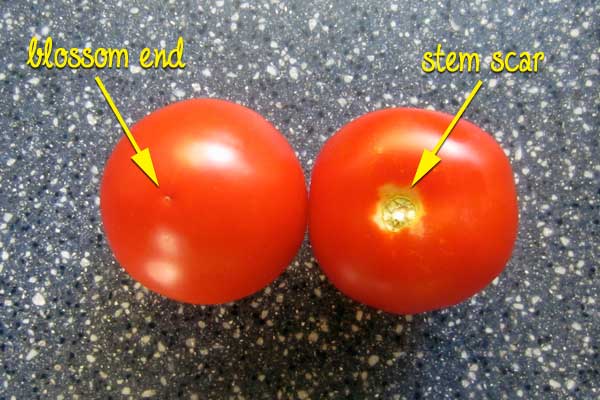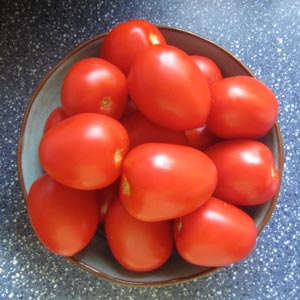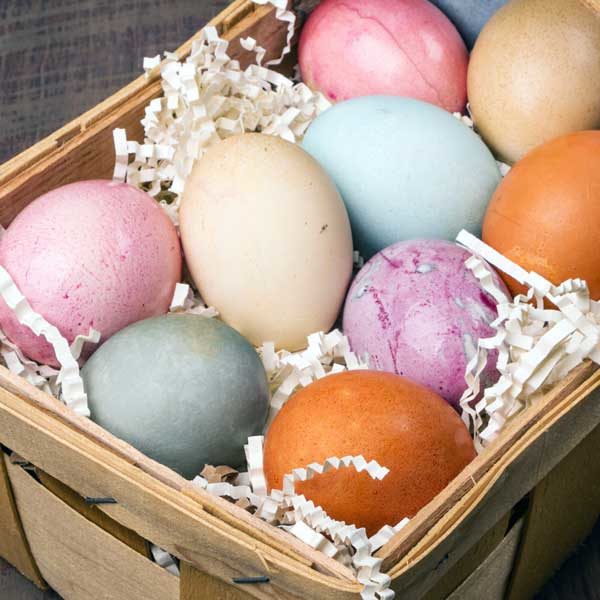This post may include affiliate links.
If you make a purchase, I'll earn a small fee at no extra cost to you.
A friend who “overshopped” at the warehouse store just gave me half a case of Roma tomatoes (another example of why it never hurts to ask!).
I usually grow my own tomatoes and just give them a quick rinse before using. However, these were coated with food wax and had been handled by many little kids–so I wanted to wash them thoroughly.
A quick web search left me confused. Should I buy a vegetable wash spray? Soak them in a sink full of vinegar and water? Scrub with a soft brush?
I even saw an article that recommended washing produce in a sink full of water and bleach. Ummm…no way in heck.
Thank goodness for the Master Gardeners! They directed me to a university study on cleaning and storing tomatoes, so I have the best info to pass on to you.
Before we clean our tomatoes though, we need to have a lesson in basic tomato anatomy. Don’t worry, Mom, this is completely G-rated.
The end of the tomato that is attached to the plant is the stem. When you pull the tomato off the plant, the little brown divot is called the stem scar. The other end is called the blossom end. Ever heard a gardener talking about blossom end rot? It happens to the best of us.
Why does the anatomy lesson matter? Because the stem scar is a weak point in the tomato’s skin. If you soak your tomatoes in a sink full of produce wash or vinegar water, any crud that washes off the tomato skin could potentially contaminate the tomato flesh through the stem scar.
So how do you wash tomatoes, then? According to the Master Gardeners, you should rinse, rub the surface, rinse again, and dry. After washing, cut away the stem scar and surrounding area and discard it before slicing or chopping the tomato. You can either compost these pieces or feed them to a nearby critter (my turtle loves them–worms would too).
Did I mention that I have a LOT of tomatoes sitting around?!?








Never got the chance to enjoy our backyard tomatoes, as the squirrels got to them first. A lesson learned the hard way.
Very good info, we have always washed our tomatoes by hand bascially using this same technique so it’s great to know that we have been doing it right!
Something that we never had to worry about with Heirloom Tomatoes. Thanks for doing the research and letting us know.
I use baking soda to wash my tomatoes. I wet the tomato, sprinkle a light layer of baking soda over it, rub it GENTLY, and rinse. Dry with a paper towel. This takes all that waxy stuff off the tomato.
Thank you for your research! Seriously, bleach your tomatoes? What were they thinking in that article?! LOL
My mouth is watering! We have lots of tomatoes forming on the vines already! We use our recipes in waves. First few go into salads to bulk it up due to the slow down of lettuce growth. By the time the lettuce no longer produces the tomatoes are coming in stronger and we make bruschetta (basil is just starting) or no-cook salsa. As the volume of tomatoes increase we start roasting them (halved, brushed with olive oil, doused w/ garlic & parmigiana cheese) or making a cooked salsa recipe; then we move onto pasta sauces with zucchini added because there aren’t quite enough tomatoes for a big pot. As summer progresses our sauce get better by adding the red bell peppers. When we have too much to eat, but not enough to can, I cut an X in the blossom end and freeze whole (peels slip right off). Once the freezer has enough, I thaw & can sauce adding in all garden bounties–zucchini, basil, oregano, red bell peppers, garlic and parsley. By seasons end 🙁 we are eating fried green tomatoes.